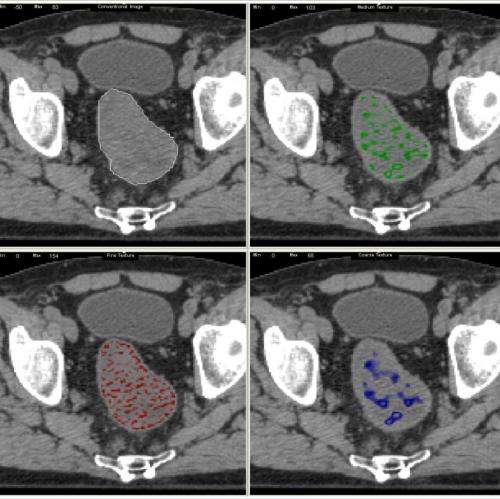A standard CT scan (top left) with the tumor outlined in white. With the TexRAD software applied, healthcare professionals can analyze the tumor's texture at a fine (red), medium (green) and coarse (blue) level. Image courtesy a bowel cancer case analysis from University College London Hospital. Credit: Feedback plc
Technology developed at the University of Sussex helps hospitals make earlier and more accurate treatment decisions and survival assessments for patients with bowel cancer.
Bowel cancer kills more than 16,000 people a year in the UK, making it the nation's second-most common cause of cancer death (after lung cancer).
A novel medical-imaging technology, TexRAD, which analyses the texture of tumours, has been shown in trials to enable early diagnosis of those bowel-cancer patients not responding to the standard cancer therapy better than other available tumour markers.
Furthermore, the TexRAD markers showed the ability to assess at an early stage the likelihood of survival, distinguishing patients who will have a good prognosis from those having poor prognosis.
Dr Balaji Ganeshan, one of the Sussex academics whose research led to the development of the technology, said: "By using TexRAD to scan for subtle anomalies in a tumour's texture, researchers have been able to spot more quickly when treatments are - or are not - working and adjust treatment accordingly.
"And because TexRAD simply provides an additional layer of software analysis of the MRI and CT scans that already exist as part of routine clinical practice, it is non-invasive from the patient's point of view and potentially cost-effective to the healthcare provider."
The technology is being evaluated in a number of prestigious research institutions and university hospitals around the world.
Across two separate UK studies, researchers analysed the tumours of 155 bowel-cancer patients.
In a study at University College London Hospitals, researchers analysed baseline PET-CT scans - ie those taken before treatment - and then followed up with the patients for an average of three years later. They found that analysing the texture of the tumours in the initial scans enabled them to accurately predict patient survival.
At Colchester General Hospital, the researchers looked at MR scans taken both before treatment and six weeks after the patients had completed chemotherapy and radiotherapy, and found that the patients whose tumours were less heterogeneous - ie more uniform - in terms of texture parameters six weeks after treatment were more likely to survive longer.
Meanwhile, researchers from the University of Rome found that texture analysis provides useful 'imaging biomarkers' that indicate how the tumour is responding to chemotherapy and radiotherapy. Professor Andrea Laghi, Professor of Radiology at the University of Rome and principal investigator of the study, said: "The identification of new, accurate imaging biomarkers such as TexRAD analysis of MR images for early assessment of first-line cancer therapy response (predominantly to shrink the tumour before the main treatment) could be helpful in refining bowel-cancer patient management, providing a better targeting of preoperative therapy."
The findings of the three studies will be presented to a wide international audience of clinicians (radiologists), imaging scientists, healthcare providers and industry at the 100th premier annual scientific meeting and exhibition of the Radiological Society of North America (RSNA), which takes place in Chicago from 30 November until 5 December.
Provided by University of Sussex


















